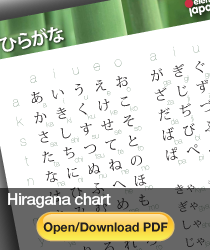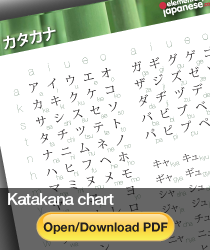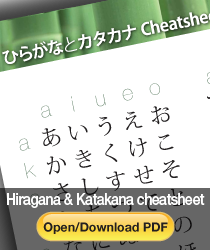Japanese Writing Downloads
Hiragana Chart (PDF)

Katakana Chart (PDF)

Hiragana and Katakana Cheatsheet
This one will be especially useful when you have learned Hiragana and Katakana but sometimes forget a character or two.
Japanese Writing
There are three basic scripts used for writing Japanese (plus many foreign words are written using the Latin alphabet). They are two syllabic scripts – Hiragana (ひらがな) and Katakana (カタカナ). The writing system used in Japanese are however the Chinese characters, in Japanese called Kanji (漢字).
I want to learn how to write Japanese. Where should I start?
If you're just beginning with Japanese, we recommend that you learn Hiragana even before you learn your first words. Or even better start learning words as soon as you can write them using the characters you know. Hiragana is not that hard, it's basically 46 symbols plus some rules combinations. You can master it in a few days so don't postpone it, you'll need it anyway and as soon as you master the characters, you'll start getting really fast in it as long as you use it.
When you have learned Hiragana and a few words, maybe how to form basic sentences, it's time to start learning Katakana. Each Katakana character has a Hiragana counterpart and the rules are basically the same (as an exception can be seen a difference in marking the length of vowels, namely in foreign words). And learning Katakana will be even easier than learning Hiragana, because sometimes the characters look a bit like their counterparts and you can practice with all the foreign words used in today's Japanese.
You will find that texts that are all in Hiragana are kind of hard to read. That's because in Japanese there are no gaps between words in writing and also because there are many homonyms (words that sound the same) that are the same when you write them in Hiragana only. Incredible as it may sound, Kanji, the Chinese characters will help you read Japanese texts. (Not that it would be your choice if they are going to be used:))
Anyway, find a system that will work best for you. You might want to try learn every Kanji you encounter and that's commonly used. If you have someone to consult it with, go ahead. Or you might want to process as JLPT (Japanese Language Proficiency Test) levels recommend (the lowest level, called JLPT N5, includes around 100 most common Kanji characters). That will be a great way to learn Kanji as you will start with those that are most commonly used. An alternative would be following the Japanese elementary school grades (starting with about 100 Kanji in 1st grade).
Any system that will work for you and that will make sure you learn Kanji every week is good. Make one and keep following it. There are many Kanji but you can master all those you need!
Glossary
Hiragana
Japanese syllabic alphabet (or syllabary). It has 46 characters and it can form 101 different syllables.
Kana
Kana is a general name for Hiragana and Katakana, the Japanese syllabic alphabets.
Katakana
Similar to Hiragana, Katakana has 46 characters that can form 101 different syllables and is used in Japanese most importantly for writing foreign names. When you know Katakana, you will be able to read many words used in today's Japanese, especially on the internet, where English words often prevail.
Kanji
A Japanese name for chinese characters. There are about 2000 kanji recommended as minimum knowledge in Japan (these kanji are used in law and everyone should master them), for reading a good-quality newspaper you might need to have knowledge of as much as 4 to 5 thousand Kanji. More about Japanese Kanji
Furigana
Often you'll see small hiragana above a kanji indicating its pronunciation. This is called Furigana.
Okurigana
Okurigana is the part of a verb or other part of speech that changes forms (mainly adjectives and verbs in Japanese) that is written in Hiragana. With writing Okurigana we often indicate grammatical categories of a verb, such as tense or modus.Syllabary
Syllabic alphabet – an alphabet where one character represents one syllable.